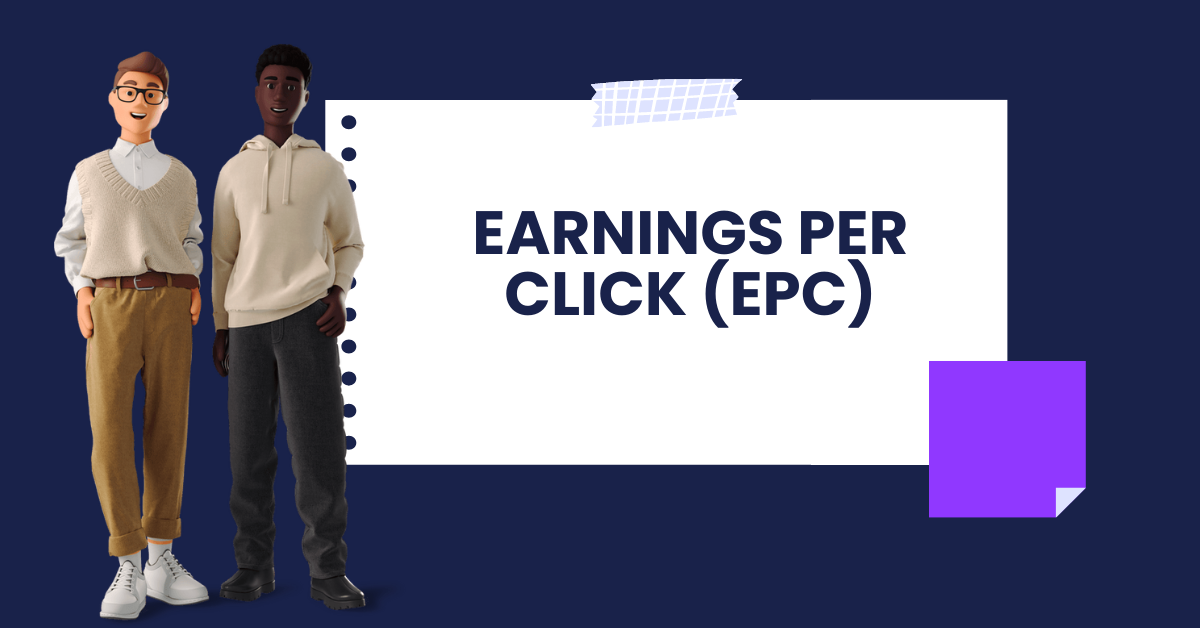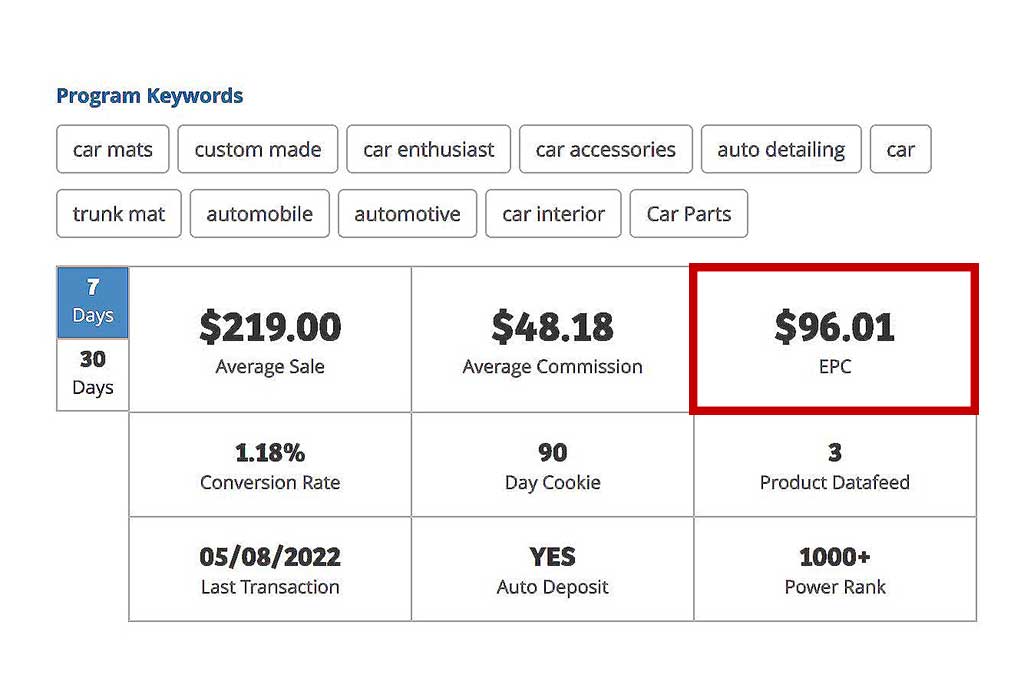
As an affiliate marketer, do you know the value of each click on your affiliate offers? Tracking performance metrics is essential to measure affiliate campaigns’ profitability and effectiveness. Earnings per Click is one such metric that plays a vital role in evaluating the success of affiliate marketing campaigns. So, what is EPC in affiliate marketing?
In this post, we’ll discuss EPC in affiliate marketing, its significance, how to calculate EPC, and how to enhance the EPC of affiliate marketing campaigns.
What Is EPC in Affiliate Marketing?
EPC (earnings per click) is a vital performance metric used in affiliate marketing to analyze the profitability and effectiveness of affiliate campaigns. It usually represents your average earnings when someone clicks on your affiliate link.

EPC offers insights into whether a product is worth your time, effort, and resources. It considers the number of clicks generated and the resulting revenue. A higher EPC shows that a campaign is more profitable since it generates more revenue per click and vice versa.
What Is the Significance of EPC in Affiliate Marketing?
Here are some main reasons why EPC is important in affiliate marketing.

1. Performance Assessment
EPC usually serves as a performance metric that allows you to assess the financial performance of your affiliate campaigns. It offers insights into the affiliate marketing revenue generated per click on affiliate offers. By comparing earnings per click across different campaigns, you can identify offers that are more successful in generating revenue and those that require optimization.
2. Offer Selection
You can use EPC to identify profitable offers to promote. By considering the historical EPC data given by affiliate platforms such as Amazon Associates, you can make informed decisions about the offers to promote. As mentioned earlier, offers with higher EPC values have greater revenue potential, making them attractive options for marketers.
3. Campaign Optimization
You can boost your campaigns’ performance by tracking EPC. You can identify the most performing offers by analyzing EPC data and allocating resources accordingly. Besides, you can focus on promoting offers with a higher EPC, adjust ad creatives, refine your targeting strategies, and optimize your conversion funnels to maximize your earnings.
4. Profitability Analysis
EPC is directly linked to the profitability of affiliate marketing campaigns. Again, a higher EPC means higher earnings per click, which ultimately translates to greater profitability. By tracking and enhancing EPC, you can increase your revenue and achieve a higher return on investment from your affiliate marketing efforts.
5. Performance Comparison
EPC allows you to compare the performance of different campaigns, offers, or traffic sources. Besides, it helps you identify which channels or campaigns are delivering the best results in terms of revenue generation. This information will empower you to allocate your resources effectively, expand successful campaigns, and make informed decisions to drive overall success in your affiliate marketing efforts.
How to Calculate EPC in Affiliate Marketing
Here are the practical steps to follow in calculating your EPC in an affiliate program:

Step 1: Determine the Total Affiliate Marketing Earnings
Determine the total amount of money generated from the affiliate program you want to track. You can get this from your affiliate network by following affiliate sales and commissions made by your affiliate links.
For instance, assume you have earned $50,000 in commissions from your affiliates over the past month.
Step 2: Count the Total Clicks
Determine the number of clicks your affiliate links received within the same period you calculated your affiliate earnings. You can get this information from your affiliate network or link-tracking tools.
Let’s assume you have 2,500 clicks on your offers.
Step 3: Divide Total Earnings by Total Clicks
To get your average earnings per click, divide the total affiliate revenue by the total clicks.
EPC = total earnings by affiliate partner divided by the number of clicks your affiliate program’s partner sent through their tracking links.
Therefore;
EPC= 50,000/2,500
Your EPC will be $20 per click.
Step 4: Analyze the Results
The resulting EPC value will show how much affiliate revenue is generated per click on your affiliate links on average. As mentioned earlier, higher EPC levels imply your campaigns are doing well. At the same time, lower values show that you need to improve.
In some cases, this data is usually referred to as “network EPC” since it comes from the affiliate program’s network of partners to generate the average. Since affiliate networks’ earnings per click give you this data, to help you choose your affiliate products more wisely, you might think, “If you know your EPC, why doesn’t everyone choose products with a higher EPC and pump ads to that affiliate link?”
The issue is that these are average EPC, meaning they differ for all affiliate partners. One person might link to a product with an EPC of $0.3 and another with an EPC of $0.1. This means the average of an EPC is $0.2.
Best Practices to Improve Your EPC of Affiliate Marketing Campaigns
1. Use Affiliate Links in Your Blog Posts
Include affiliate links in your blog posts. It’s not a secret for affiliate marketers that creating quality content may attract massive amounts of organic traffic to your site. If your site has a consistent blog page, you can start creating content for your affiliate product, always prioritizing value.

Remember to follow the best SEO practices, whether you want to create a blog or already have one. This allows you to get more website visitors and rank higher in search engines. Then you can include the affiliate links directly in the content to increase sales.
Besides, you can use popups on your site to improve blog post interaction in the first place.
2. Convert Abandoning Visitors with Exit-Intent
You should know that re-engaging is a gem when it comes to digital marketing. You can create a targeted exit-intent popup for your affiliate products and display it on your site. We recommend using Popupsmart exit-intent technology in that situation and for other marketing uses.
So, how do exit-intent popups really work for affiliate products?
When visitors browse a certain page on your website, they will see a popup if they intend to abandon the web page. On your exit popup, you will display an offer and include a call-to-action button that directs users to your affiliate products. If your target audience is interested, they will buy, and you will make more affiliate sales.
The good thing about exit-intent popups is that they come from organic traffic; you won’t pay for expensive affiliate paid ad campaigns. This results in lower ad costs, a high EPC, and a higher total profit.
3. Leverage Affiliate Marketing via Email Series
Using an affiliate email marketing series is an effective way to enhance your EPC marketing. However, keep in mind that using affiliate links in email marketing can bring you profits or get you banned from using your email service provider.

The difference between the two outcomes depends on your approach. Although email service providers don’t want spam emails because they lower their open rate percentages, when they see a large email list sending out campaigns with affiliate links, they consider it spam and shut it down.
However, this does not mean you can’t add affiliate links to your emails. Creating an email sequence that does not appear spammy would be best. Your EPC marketing automated email series can look like this:
- Welcome email
- Affiliate link email
- More content sharing
- Sharing content
- Lead nurturing to build a connection.
Also, you can create newsletters that will allow you toconvenientlycommunicate with your customers and prospects in a customized way by serving quality content and relevant promotions direct to their inboxes.
4. Monitor Metrics to Cut Out Baggage
Marketing efforts can only be successful once you know what you want to achieve. Similar to business call forwarding, if it doesn’t get to where it has to be, you’re not making the progress you intended. Before starting your affiliate marketing campaign, we recommend deciding on the targets you want to achieve with it. Also, ensure you have a way to monitor how well your campaign is going as you go along.

These analytics can often identify any specific issues you have besides helping you determine whether you are on track. It would be best if you didn’t dismiss these shortcomings because fixing them can improve your campaign’s overall performance.
5. Find Products with Higher Payouts
This could be challenging if you’re starting because many affiliate marketing sites require approval. However, you can find products with better deals if you conduct a quick Google search.
Furthermore, you can consider high-ticket affiliate marketing, focusing on premium products with higher earning potential. Alternatively, if you want something more significant than what you now have, search for your product, brand, and affiliate program.
For example, if you’re in the fitness industry, it may look like this:
- Fitness affiliate programs
- Fitbit affiliate programs
6. Focus on Fast Hosting
What most affiliate marketers don’t know about EPC is that visitors won’t click on your affiliate links, in-content links, or ads if you can’t make them stay on your website. According to a study, the average site load time is 10.3 seconds on desktops and 27.3 seconds on mobile devices. Even just a one-second delay will reduce the:
- Conversions by 7%
- Pageviews by 11%
- Customer satisfaction by 16%
Keeping your hosting quick and reliable would attract more visitors and increase clicks on your affiliate links and EPC email marketing.
7. Keep Track of Affiliate Campaign Historical Data
Some affiliate marketing networks usually show how long merchants have been active on their platform. This helps determine the reliability of a specific vendor. For instance, if you use ClickBank, you can filter results by date by going to Affiliate Marketplace > Advanced Search.
Other affiliate websites go a step further and indicate merchants with low funds. For instance, to see this on ShareASale, go to any seller’s affiliate program page and click “Status History.”This also shows how long they have been online.
From the inside, you will also see if they have low funds. A merchant with insufficient funds could be a warning sign affecting your rewards. This might help you determine whether you’re waffling between two programs.
Conclusion
Earnings per click (EPC) is an important metric in affiliate marketing. It allows affiliate marketers to evaluate their campaigns’ performance, choose lucrative offers, improve campaigns, analyze their profitability, and compare the effectiveness of other campaigns or traffic sources. To calculate your EPC, divide the sum of earnings by the affiliate partner by the number of clicks your affiliate program’s partner sent through their tracking links.

Affiliate marketers can use different affiliate marketing strategies to enhance the EPC of their campaigns. These include implementing email marketing campaigns with strategically placed affiliate links, using affiliate links in blog posts to drive organic traffic, tracking affiliate campaign historical data to ensure reliability, and many more.
Frequently Asked Questions on EPC Email Marketing
1. What is EPC in email marketing?
Earnings per click (EPC) is a vital performance metric used in affiliate marketing to analyze the profitability and effectiveness of affiliate campaigns and shows the average revenue you generate each time someone clicks on your affiliate links.
2. What does EPC stand for in advertising?
In this context, EPC means “earnings per click.” You can use many metrics to evaluate your email marketing efforts, and EPC is one of them. This represents a per-click measure of how much your traffic is earning from advertisers.For a particular volume of clicks, the higher your earnings per click, the higher your earnings.
3. What is a Good EPC in Affiliate Marketing?
A good EPC is when your earnings per click are higher than your cost per click. So, as long as you’re always earning more than you spend, you will be profitable.
4. What is a 7-day EPC in affiliate marketing?
The 7-day EPC measures the average earnings per click over the past week. It’s calculated by dividing the total affiliate earnings by the number of clicks within seven days. For instance, $50/1,000 = 5 cents.
